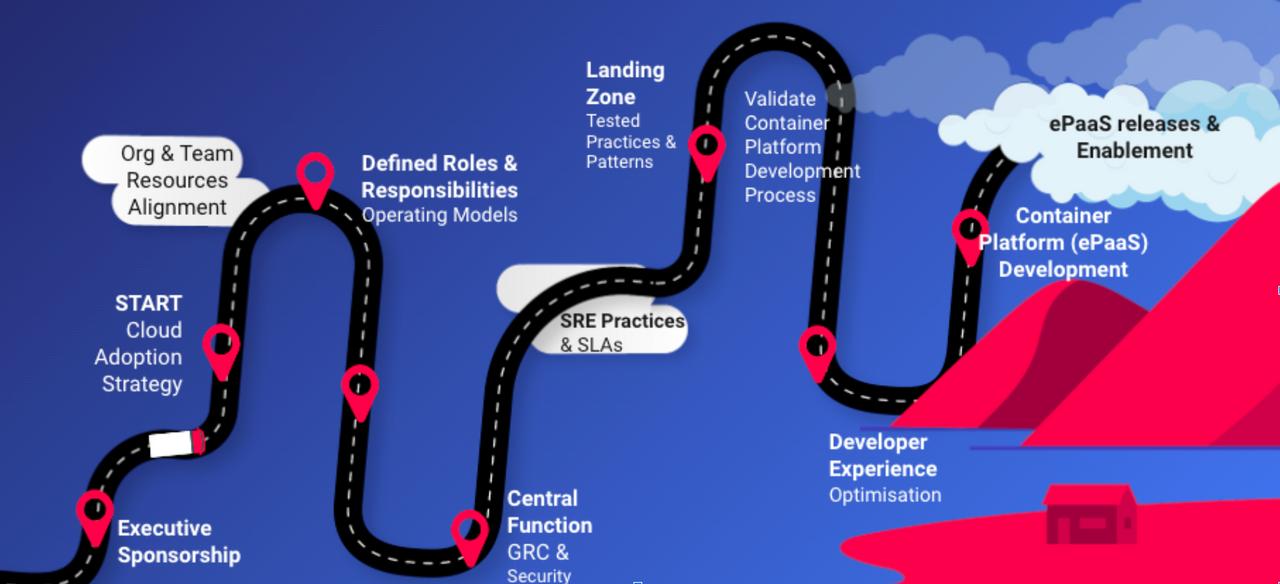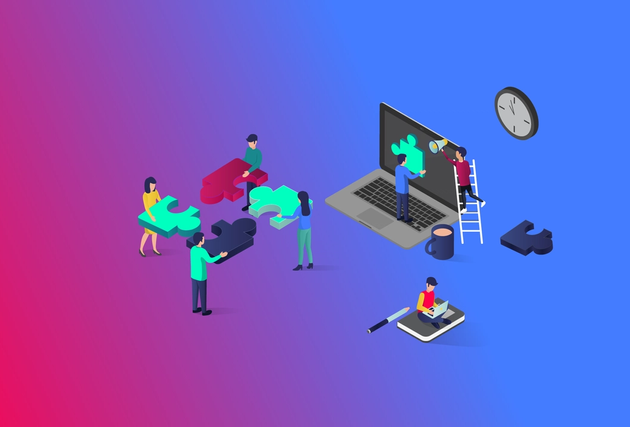How to Lay a Robust Foundation for a Successful Container Platform Rollout
A container platform rollout isn't just a technological shift; it's a transformational strategy that aligns with the broader goals of an organisation.
As organisations navigate the digital landscape, the need for agility, scalability, operating efficiency and leaner time-to-market is paramount, so businesses are increasingly looking to container platforms as a solution. The success of a container platform, however, hinges on its alignment with the organisation's transformational strategy, which should cover not only technological changes but also cultural shifts and stakeholder buy-in that will drive holistic organisational change.
In this blog, we’ll explore what a container platform is, how it can help businesses deploy microservices at scale, and how to ensure your business is in the best position for a successful rollout.
“With the prevalence of containers and Kubernetes in today’s IT infrastructure, container platforms are critical not just to the technical goals of organisations, but also to overall business outcomes” - Mark Faiers, AWS Practice Lead
What's a Container Platform?
A container platform is a streamlined container orchestration solution for organisations to deploy microservices at scale.
Kubernetes has rapidly evolved to become the de facto standard for container orchestration, and its maturity is evident in the robust Kubernetes container service offerings from the three leading hyperscalers, AWS, Azure and Google Cloud. These offerings come with the assurance of hyperscaler expertise to ensure that the foundational aspects of the platform are not only robust but are also continually updated and maintained. This external maintenance by hyperscalers alleviates significant operational overhead, so that internal platform teams can focus on extending the capabilities of the managed Kubernetes service. This in turn allows them to tailor the environment to meet the organisation's unique technical features, compliance requirements, policies and controls.
Key benefits
- Holistic organisational alignment. A harmonised environment that aligns with internal standards and empowers adoption when backed by robust SLOs and transparent SLAs.
- Digital transformation catalyst. Clear strategic planning and introspection ensures that the container platform isn't just another tech project, but a strategic overarching digital transformation journey and internal business value-generator that it is.
- Strategic cloud adoption - A well-articulated cloud and cloud-service-backed platform adoption strategy is critical towards a cohesive Cloud Centre of Excellence.
- Engagement and feedback. The regular platform service updates and demos are more than just informational sessions; they're powerful tools to showcase platform capabilities to ensure the long term relevance and quality of such Internal Platform Service offering.
Container Platforms as an Internal Service Offering
The internal container platform typically builds upon a cloud-hosted kubernetes as-a managed-services foundation that enables organisations to offer their development teams a platform that is not only compliant with internal standards but also backed by robust service level objectives (SLOs) and service level agreements (SLAs). In turn, such assurance empowers product teams to shift their focus from the intricacies of platform management to what truly matters—delivering business value.
With the organisation navigating cloud adoption, now with operational resilience and developer experience (DevEx) at its core, container platforms should be a serious consideration to achieve the many aforementioned benefits. The journey to successfully integrating container platforms as an internal service offering is paved with introspection, strategic planning and a clear understanding of the organisation's current state.A pivotal aspect of this introspection revolves around the organisation's cloud adoption strategy. A well-defined strategy should include answers to key questions, such as:
- Is there a mature landing zone already established, providing a dedicated account or project vending in the cloud estate?
- Are there dedicated teams and resources in place, ready to champion this container platform initiative?
- Is the Centre Cloud of Excellence—a collection of security, networking, compliance and other governance decision makers and champions—aligned to support the delivery of such an internal service offering within the organisation?
”Many cloud vendors have enhanced the standard container offering with various integrations into their cloud services, such as security and publishing to the internet. These integrations are critical to realising a successful container platform the business can rely on.” - Nick Kinch, Azure Practice Lead
The success of any transformative initiative like container platforms hinges on strong leadership and vision. Who within the organisation will champion this project? Is there a clear understanding and consensus of where the container platform fits within the broader organisational strategy? Ideally it should not be treated as a one-off project, confined to a single business domain in the organisation.
Having clear answers to these questions ensures that the container platform initiative is not just another standalone technical project but a strategic move that propels the organisation forward in its digital transformation journey.
The regular platform development updates and demo cadence is an incredibly motivating and powerful way to both promote the platform’s capabilities and to take teams on this development journey. Usually the early platform adopters are teams and colleagues in those early playback sessions who offer early feedback, ensuring platform adoption success.
Fundamental Frameworks and Principles
The Cloud Adoption Framework (CAF from Azure, AWS and GCP) and the DevOps Research and Assessment (DORA) principles are both instrumental in guiding organisations through their cloud enablement journeys, and include initiatives such as adoption of managed Kubernetes services for container platform development. While they serve different primary purposes, their intersection, especially in the context of container platforms and SLA targets, is crucial for organisations aiming for operational excellence in the cloud.
What’s the Cloud Adoption Framework?
The Cloud Adoption Framework is a structured approach provided by cloud vendors such as AWS, Microsoft Azure and Google Cloud to help organisations successfully adopt cloud services. It encompasses various aspects, from business and technical perspectives to people and processes. The CAF provides guidance on best practices, strategies and design principles to ensure successful cloud adoption.
DORA principles
DORA focuses on the principles and practices that drive high performance in software delivery and operational performance - think Developer Experience (DevEx). It emphasises the importance of DevOps practices, continuous delivery, automation, and a culture of continuous improvement.
Why do these frameworks matter?
In the context of container platforms, the CAF and DORA crossover affords a multi-faceted alignment on principles and target excellence. Both CAF and DORA emphasise the importance of aligning technical initiatives with business objectives, which means ensuring that the platform's design, deployment and operational strategies align with the organisation's broader goals and objectives. It's vital for the organisation's technical leadership to be well-versed with these frameworks. The regular and continuous communication with individual business domains throughout the platform development phases ensures sustained alignment with the overarching platform delivery goals.
DORA's principles around continuous delivery and automation can be mapped to the operational excellence pillar of CAF. For container platforms, this translates to ensuring automated deployments, self-healing capabilities and efficient scaling to meet SLA targets. Moreover the DORA (DevOps Research and Assessment) report has consistently highlighted the benefits of adopting DevOps and SRE practices. These practices, when thoughtfully implemented, can lead to higher organisational efficiency, faster delivery times, and improved reliability.
CAF's security pillar, combined with DORA's emphasis on automated security practices, ensures that container platforms are both secure by design and in operation. This is crucial for meeting stringent SLA targets, especially in regulated industries.
“One does not simply build a platform with no SLAs”
Finally, the Cloud Adoption Framework encourages and ensures that all stakeholders, from business to technical teams, are aligned in their objectives. This alignment is crucial for setting and reaching realistic SLA targets. Navigating through SLAs requires a multi-tiered approach. While the cloud vendor provides foundational SLAs to your organisation, the platform team then delineates its own SLAs to the internal stakeholders within the organisation. Such clarity is critical when establishing SLA benchmarks for new internal platforms buildouts.
Diagram illustrating the separation of responsibilities and SLAs
Roadmap to Success
If you’re ready to embark on your container platform journey, here is a structured guide to ensure the development and release are both effective and timely:
- Evaluate infrastructure readiness
- Ensure a clean and successful landing zone. Provision projects and accounts tailored to specific business domains and environments.
- Scalability and Performance. Design the platform for varying loads. Consider regional requirements and any multi-cloud design needs.
- Security and compliance
- Consult with security and networking teams to ensure viable environments, accounts, and projects for internal teams.
- Central Governance, Policies, Controls (GRC) and Logging. Prioritise security and compliance. Regularly conduct penetration testing and maintain an architecture decision log.
- Security best practices. Implement security logging and controls from the outset. Consider container platform consumption methods, multi-tenancy, IAM, RBAC controls, and responsibility for security threats in a multi-tenanted environment.
- Development and operations
- Shared services and integrated DevOps toolchain. Ensure seamless deployment, management and monitoring and relevant alerting.
- Developer experience (DevEx) tools and processes. Equip development teams with necessary tools and establish a shared responsibility model. Start with a robust CI/CD process. Implement Self-Service capabilities where possible to unblock teams with operational delays and blockers.
- Image and container bakeries. Define and streamline internal container and image build processes, which could be blockers for some container platform features.
- Cost management and cost centre attribution
- FinOps. Monitor and manage cloud costs diligently. As this container platform is released, this has a tendency to scale fast, when adopted successfully. Watch that spend and Optimise.
- Training and communication
- Training and documentation. Keep teams updated and ensure effective platform use. Regularly update teams with show & tell sessions and avoid secretive development channels.
- Ensure your team is trained and equipped with the relevant skills such as Kubernetes administrator to ensure they are implementing and adhering to best practices at all times.
- Process optimisation with feedback loops. Maintain transparency with continuous feedback channels, regular architecture reviews, and up-to-date architecture designs.
- Governance, risk and compliance (GRC)
- Set rules and policies governing cloud use within the organisation. This should have its own dedicated sessions to walk-through progress updates.
- Resilience and Recovery
- Disaster recovery and high availability. Plan for container platform upgrades and releases in production. Prepare for potential downtimes, understand the MTTR, and ensure platform resilience.
This is a reasonably exhaustive list to walk through and to help organisations lay a robust foundation for a successful container platform rollout, ensuring it aligns with their operational resilience journeys.
Summary
Navigating the container platform landscape is like piecing together a complex puzzle, as is clear from the CNCF’s landscape of technology offerings that run in containers and potentially in your very container platform environment. Alas, it's not merely about a tech solution; it's about weaving it into the very fabric of the organisation, ensuring every piece is aligned with the bigger picture for sustainable long-term success.
If you’d like to learn more about container platforms and how to ensure successful rollouts, please reach out to us at Contino and we'd be happy to help.








